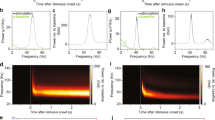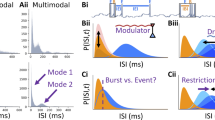Abstract
Periodic neural activity not locked to the stimulus or to motor responses is usually ignored. Here, we present new tools for modeling and quantifying the information transmission based on periodic neural activity that occurs with quasi-random phase relative to the stimulus. We propose a model to reproduce characteristic features of oscillatory spike trains, such as histograms of inter-spike intervals and phase locking of spikes to an oscillatory influence. The proposed model is based on an inhomogeneous Gamma process governed by a density function that is a product of the usual stimulus-dependent rate and a quasi-periodic function. Further, we present an analysis method generalizing the direct method (Rieke et al. in Spikes: exploring the neural code. MIT Press, Cambridge, 1999; Brenner et al. in Neural Comput 12(7):1531–1552, 2000) to assess the information content in such data. We demonstrate these tools on recordings from relay cells in the lateral geniculate nucleus of the cat.
Similar content being viewed by others
References
Adrian ED (1942) Olfactory reactions in the brain of the hedgehog. J Physiol 100(4): 459–473
Aldworth ZN, Miller JP, Gedeon T, Cummins GI, Dimitrov AG (2005) Dejittered spike-conditioned stimulus waveforms yield improved estimates of neuronal feature selectivity and spike-timing precision of sensory interneurons. J Neurosci 25(22): 5323–5332
Ahissar E, Vaadia E (1990) Oscillatory activity of single units in a somatosensory cortex of an awake monkey and their possible role in texture analysis. Proc Natl Acad Sci USA 87(22): 8935–8939
Barlow HB, Fitzhugh R, Kuffler SW (1957) Change of organization in the receptive fields of the cat’s retina during dark adaptation. J Physiol 137(3): 338–354
Barrett P, Hunter J, Miller JT, Hsu JC, Greenfield P (2005) Matplotlib—a portable python plotting package. Astron Data Anal Softw Syst XIV ASP Conf Ser 347: 91–395
Barbieri R, Quirk MC, Frank LM, Wilson MA, Brown EN (2001) Construction and analysis of non-Poisson stimulus–response models of neural spiking activity. J Neurosci Methods 105(1): 25–37
Berman M (1981) Inhomogeneous and modulated gamma processes. Biometrika 68(1): 143–152
Borst A, Theunissen FE (1999) Information theory and neural coding. Nature Neurosci 2: 947–957
Brenner N, Strong SP, Koberle R, Bialek W, Steveninck RRR (2000) Synergy in a neural code. Neural Comput 12(7): 1531–1552
Brown EN, Barbieri R, Ventura V, Kass RE, Frank LM (2002) The time-rescaling theorem and its application to neural spike train data analysis. Neural Comput 14(2): 325–346
Bruno RM, Sakmann B (2006) Cortex is driven by weak but synchronously active thalamocortical synapses. Science 312(5780): 1622–1627
Castelo-Branco M, Neuenschwander S, Singer W (1998) Synchronization of visual responses between the cortex, lateral geniculate nucleus, and retina in the anesthetized cat. J Neurosci 18(16): 6395–6410
Eckhorn R, Popel B (1975) Rigorous and extended application of information theory to the afferent visual system of the cat. II. Experimental results. Biol Cybern 17(1): 71–77
Fellous JM, Houweling AR, Modi RH, Rao RPN, Tiesinga PHE, Sejnowski TJ (2001) Frequency dependence of spike timing reliability in cortical pyramidal cells and interneurons. J Neurophysiol 85(4): 1782–1787
Freeman WJ (1972) Measurement of oscillatory responses to electrical stimulation in olfactory bulb of cat. J Neurophysiol 35(6): 762–779
Fries P, Nikolić D, Singer W (2007) The gamma cycle. Trends Neurosci 30(7): 309–316
Gelperin A, Tank DW (1990) Odour-modulated collective network oscillations of olfactory interneurons in a terrestrial mollusc. Nature 345(6274): 437–440
Gray CM, Koenig P, Engel AK, Singer W (1989) Oscillatory responses in cat visual cortex exhibit inter-columnar synchronization which reflects global stimulus properties. Nature 338(6213): 334–337
Heiss WD, Bornschein H (1966) Multimodal interval histograms of the continuous activity of retinal cat neurons. Kybernetik 3(4): 187–191
Hodgkin AL, Huxley AF (1952) Currents carried by sodium and potassium ions through the membrane of the giant axon of Loligo. J Physiol 116(4): 449–472
Hutcheon B, Yarom Y (2000) Resonance, oscillation and the intrinsic frequency preferences of neurons. Trends Neurosci 23(5): 216–222
Ishikane H, Gangi M, Honda S, Tachibana M (2005) Synchronized retinal oscillations encode essential information for escape behavior in frogs. Nat Neurosci 8(8): 1087–1095
Jarvis MR, Mitra PP (2001) Sampling properties of the spectrum and coherency of sequences of action potentials. Neural Comput 13(4): 717–749
Kenyon GT, Theiler J, George JS, Travis BJ, Marshak DW (2004) Correlated firing improves stimulus discrimination in a retinal model. Neural Comput 16(11): 2261–2291
Koepsell K, Wang X, Vaingankar V, Wei Y, Wang Q, Rathbun DL, Usrey WM, Hirsch JA, Sommer FT (2008) Retinal oscillations carry visual information to cortex (submitted)
Koyama S, Shinomoto S (2005) Empirical Bayes interpretations of random point events. J Phys A Math Gen 38(29): L531–L537
Kuffler SW, Fitzhugh R, Barlow HB (1957) Maintained activity in the cat’s retina in light and darkness. J Gen Physiol 40(5): 683–702
Laurent G, Davidowitz H (1994) Encoding of olfactory information with oscillating neural assemblies. Science 265(5180): 1872–1875
Laufer M, Verzeano M (1967) Periodic activity in the visual system of the cat. Vis Res 7(3): 215–229
Masse NY, Cook EP (2008) The effect of middle temporal spike phase on sensory encoding and correlates with behavior during a motion-detection task. J Neurosci 28(6): 1343
Munemori J, Hara K, Kimura M, Sato R (1984) Statistical features of impulse trains in cat’s lateral geniculate neurons. Biol Cybern 50(3): 167–172
Muresan RC, Jurjut OF, Moca VV, Singer W, Nikolic D (2008) The oscillation score: an efficient method for estimating oscillation strength in neuronal activity. J Neurophysiol 99(3): 1333–1353
Montemurro MA, Rasch MJ, Murayama Y, Logothetis NK, Panzeri S (2008) Phase-of-firing coding of natural visual stimuli in primary visual cortex. Curr Biol 8(5): 375–380
Nowak LG (1997) Influence of low and high frequency inputs on spike timing in visual cortical neurons. Cerebral Cortex 7(6): 487–501
Neuenschwander S, Singer W (1996) Long-range synchronization of oscillatory light responses in the cat retina and lateral geniculate nucleus. Nature 379(6567): 728–733
Ogawa T, Bishop PO, Levick WR (1966) Cortex is driven by weak but synchronously active thalamocortical synapses. J Neurophysiol 29: 1–30
Oliphant TE (2007) Python for scientific computing. Comput Sci Eng 9(3): 10–20
OKeefe J, Recce ML (1993) Phase relationship between hippocampal place units and the EEG theta rhythm. Hippocampus 3(3): 317–330
Pérez F, Granger BE (2007) IPython: a system for interactive scientific computing. Comput Sci Eng 9(3): 21–29
Perkel DH, Gerstein GL, Moore GP (1967) Neuronal spike trains and stochastic point processes: I. The single spike train. Biophys J 7(4): 391–418
Rodieck RW (1967) Maintained activity of cat retinal ganglion cells. J Neurophysiol 5: 1043–1071
Richmond BJ, Optican LM, Spitzer H (1990) Temporal encoding of two-dimensional patterns by single units in primate primary visual cortex. I. Stimulus-response relations. J Neurophysiol 64(2): 351–369
Rieke F, Warland D, van Steveninck RR, Bialek W (1999) Spikes: exploring the neural code. MIT Press, Cambridge
Szwed M, Bagdasarian K, Ahissar E (2003) Encoding of vibrissal active touch. Neuron 40(3): 621–630
Stopfer M, Jayaraman V, Laurent G (2003) Intensity versus identity coding in an olfactory system. Neuron 39(6): 991–1004
Sahani M, Linden JF (2003) Evidence optimization techniques for estimating stimulus–response functions. In: Obermayer K, Becker S, Thrun S(eds) Advances in neural information processing systems, proceedings of the 2002 conference, vol 15.. MIT Press, Cambridge, pp 109–116
Samonds JM, Zhou Z, Bernard MR, Bonds AB (2006) Synchronous activity in cat visual cortex encodes collinear and cocircular contours. J Neurophysiol 95(4): 2602–2616
Tiesinga P, Fellous JM, Sejnowski TJ (2008) Regulation of spike timing in visual cortical circuits. Nat Rev Neurosci 9(2): 97–107
Tuckwell HC (1988) Introduction to theoretical neurobiology. Cambridge University Press, Cambridge
Usrey WM, Alonso JM, Reid RC (2000) Synaptic interactions between thalamic inputs to simple cells in cat visual cortex. J Neurosci 20(14): 5461
Wang X, Wei Y, Vaingankar V, Wang Q, Koepsell K, Sommer FT, Hirsch JA (2007) Feedforward excitation and inhibition evoke dual modes of firing in the cat’s visual thalamus during naturalistic viewing. Neuron 55(3): 465–478
Author information
Authors and Affiliations
Corresponding author
Rights and permissions
About this article
Cite this article
Koepsell, K., Sommer, F.T. Information transmission in oscillatory neural activity. Biol Cybern 99, 403–416 (2008). https://doi.org/10.1007/s00422-008-0273-6
Received:
Accepted:
Published:
Issue Date:
DOI: https://doi.org/10.1007/s00422-008-0273-6




